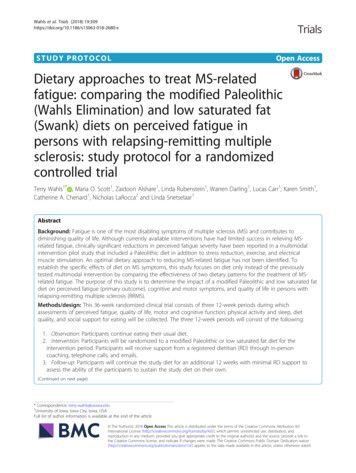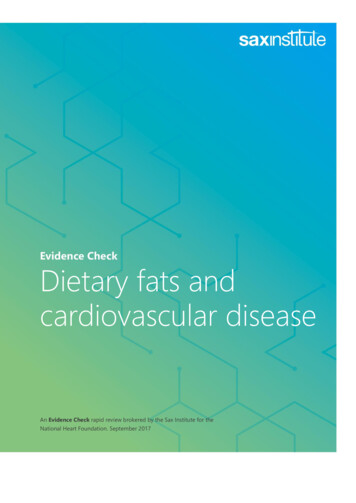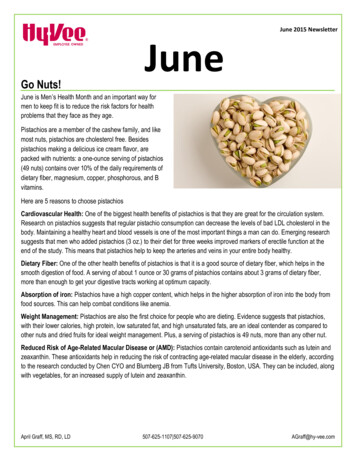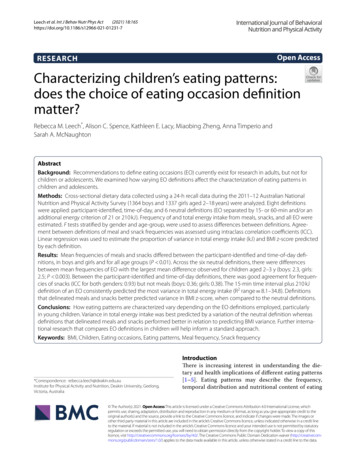
Transcription
Wahls et al. Trials (2018) DY PROTOCOLOpen AccessDietary approaches to treat MS-relatedfatigue: comparing the modified Paleolithic(Wahls Elimination) and low saturated fat(Swank) diets on perceived fatigue inpersons with relapsing-remitting multiplesclerosis: study protocol for a randomizedcontrolled trialTerry Wahls1* , Maria O. Scott1, Zaidoon Alshare1, Linda Rubenstein1, Warren Darling1, Lucas Carr1, Karen Smith1,Catherine A. Chenard1, Nicholas LaRocca2 and Linda Snetselaar1AbstractBackground: Fatigue is one of the most disabling symptoms of multiple sclerosis (MS) and contributes todiminishing quality of life. Although currently available interventions have had limited success in relieving MSrelated fatigue, clinically significant reductions in perceived fatigue severity have been reported in a multimodalintervention pilot study that included a Paleolithic diet in addition to stress reduction, exercise, and electricalmuscle stimulation. An optimal dietary approach to reducing MS-related fatigue has not been identified. Toestablish the specific effects of diet on MS symptoms, this study focuses on diet only instead of the previouslytested multimodal intervention by comparing the effectiveness of two dietary patterns for the treatment of MSrelated fatigue. The purpose of this study is to determine the impact of a modified Paleolithic and low saturated fatdiet on perceived fatigue (primary outcome), cognitive and motor symptoms, and quality of life in persons withrelapsing-remitting multiple sclerosis (RRMS).Methods/design: This 36-week randomized clinical trial consists of three 12-week periods during whichassessments of perceived fatigue, quality of life, motor and cognitive function, physical activity and sleep, dietquality, and social support for eating will be collected. The three 12-week periods will consist of the following:1. Observation: Participants continue eating their usual diet.2. Intervention: Participants will be randomized to a modified Paleolithic or low saturated fat diet for theintervention period. Participants will receive support from a registered dietitian (RD) through in-personcoaching, telephone calls, and emails.3. Follow-up: Participants will continue the study diet for an additional 12 weeks with minimal RD support toassess the ability of the participants to sustain the study diet on their own.(Continued on next page)* Correspondence: terry-wahls@uiowa.edu1University of Iowa, Iowa City, Iowa, USAFull list of author information is available at the end of the article The Author(s). 2018 Open Access This article is distributed under the terms of the Creative Commons Attribution 4.0International License (http://creativecommons.org/licenses/by/4.0/), which permits unrestricted use, distribution, andreproduction in any medium, provided you give appropriate credit to the original author(s) and the source, provide a link tothe Creative Commons license, and indicate if changes were made. The Creative Commons Public Domain Dedication o/1.0/) applies to the data made available in this article, unless otherwise stated.
Wahls et al. Trials (2018) 19:309Page 2 of 16(Continued from previous page)Discussion: Because fatigue is one of the most common and disabling symptoms of MS, effective managementand reduction of MS-related fatigue has the potential to increase quality of life in this population. The results of thisstudy will add to the evidence base for providing dietary recommendations to treat MS-related fatigue and othersymptoms associated with this disease.Trial registration: ClinicalTrials.gov, NCT02914964. Registered on 24 August 2016.Keywords: Multiple sclerosis, Fatigue, Diet, Accelerometer, Quality of life, Intervention, Swank diet, Wahlselimination dietBackgroundFatigue is one of the most common and disabling symptomsof multiple sclerosis (MS), diminishing quality of life (QOL)and contributing to early exit from the workforce [1, 2].MS-related fatigue is most commonly managed throughmultiple interventions, including disease-modifying drugsand stimulants, exercise, energy conservation, and stressmanagement techniques [3]. Although exercise augmentedby electrical muscle stimulation can be modestly effective inreducing perceived fatigue [4, 5], studies investigating the efficacy of pharmaceutical therapies have shown conflictingresults [6–8]. Because drug treatment has not been effective,dietary interventions are being explored. Statistically andclinically significant reductions in perceived fatigue severityin persons with progressive multiple sclerosis (pwPMS) havebeen reported with use of a multimodal interventionconsisting of a modified Paleolithic diet, stress reduction,exercise, and electrical muscle stimulation [4, 5].Interventions considering the whole diet (vs.supplement-based, single-nutrient focus) have beenused in treating or preventing diseases, including psoriasis[9], cancer [10, 11], and neurological diseases [12]. Emerging data support the notion that environmental ratherthan genetic factors are likely the predominant causes ofMS [13]. Given that food consumed is a major componentof the environment, it is conceivable that improving thequality of the diet may have a significant impact on thedevelopment of MS. The relationship between the qualityof the diet and MS-related symptoms such as fatigue isunknown. In this study, we will compare two dietarypatterns for the treatment of MS-related fatigue: themodified Paleolithic diet (Wahls elimination diet) anda low saturated fat diet (Swank diet).One early dietary intervention for individuals with MSwas based on the observation that high levels of saturated fat in the diet were associated with increased riskfor MS in Norway [14, 15]. Dr. Roy Swank theorized thata diet high in saturated fats causes more rapid diseaseprogression. Dr. Swank followed 144 patients with mildto more severe disability for 34 years. These individualshad agreed to consume a diet containing 20 g of saturated fat per day and report their dietary adherence. Thepatients’ clinical outcomes were monitored, includingphysical and mental performance [16–21]. The Swankstudy found that the number of relapses and progressionof disability was associated strongly with dietary saturated fat consumption [17–22]. The 50-year follow-up isa strength of the Swank study, but the absence of a control group and lack of brain imaging are limitations.Consumption of vegetables has also been associatedwith favorable health outcomes related to MS. Notably,the mean daily serving of vegetables is associated withlower risk of developing obesity [23], which is a risk factor for and a common comorbid diagnosis of those withMS. Increased consumption of vegetables is associatedwith lower Expanded Disability Status Scale scores [24],insulin sensitivity, blood pressure, body weight, and bodymass index (BMI). Considering these observations, researchers in a more recent randomized controlled trialused a vegetarian version of the Swank diet [25], alsoknown as the McDougall diet. Measures included theFatigue Severity Scale (FSS), 36-item Short Form HealthSurvey (SF-36) quality-of-life scores, lipids, weight, BMI,and brain magnetic resonance imaging (MRI) scans atbaseline and at 1 year [26]. Favorable reductions inweight, BMI, and total cholesterol were observed, but nostatistically significant differences in MRI findings orSF-36 quality-of-life scores were reported [26].Another diet of interest to the MS community is aPaleolithic diet [27]. Dr. Loren Cordain’s recommendationsfor a modern version of the Paleolithic diet stresses theconsumption of meats, vegetables, and fruits; excludesgrains, legumes, and dairy [27, 28]; and excludes nightshade vegetables (potatoes, tomatoes, peppers, and eggplants) [29] for persons with rheumatoid arthritis. Recentlytested for its impact on various biomarkers in healthyindividuals, the Paleolithic diet was associated with improvements in blood pressure, BMI [30], total cholesterol,insulin sensitivity, fasting insulin, and arterial distensibility[31]. In a study of patients with type 2 diabetes, thePaleolithic diet was shown to be more satiating per caloriethan the American Diabetes Association (ADA) diet, whichencourages increased intake of vegetables, dietary fiber,whole-grain bread and cereal products, fruits, and berriesand decreased intake of total fat with more unsaturated fat[32]. In a crossover study comparing the Paleolithic diet
Wahls et al. Trials (2018) 19:309with the ADA diet, the Paleolithic diet was superior to theADA diet with respect to improving blood pressure, lipidprofile, and glycemic control [33]. Finally, in a randomizedcontrolled study of obese persons with metabolic syndrome, comparison of the Paleolithic diet with the controldiet, which was an isoenergetic diet based on Dutch dietaryguidelines, the Paleolithic diet was associated with greaterimprovements in blood pressure, fasting levels of lipids,and weight loss than the control diet [34].A modified version of the Paleolithic diet was shown toreduce perceived fatigue in pwPMS (either secondary orprimary progressive multiple sclerosis [SPMS or PPMS, respectively]) [4, 5] as part of a multimodal intervention(modified Paleolithic diet, targeted vitamin supplementation, stress-reducing practices, exercise, and electricalmuscle stimulation). The study diet stressed the consumption of more vegetables, with a target of 6 to 9 cups ofvegetables and fruit per day, and recommended somewhatless meat than Paleolithic diets tested in the previouslymentioned studies. At enrollment, study participants wereconsuming less than 1.5 servings of vegetables per day butraised this to an average of 8 servings per day by month 12[5]. The dietary component of the multimodal interventionwas significantly associated with favorable changes inmood and cognition between baseline and 12 months,whereas the nondietary components were not [25]. It isunknown whether the dietary component of the multimodal intervention also significantly contributed to the observed reduction in perceived fatigue [4, 5]; however,several participants anecdotally reported that deviationsfrom the study diet resulted in a sharp worsening of theirfatigue and noted that the fatigue resolved with stricteradherence to the study diet. Data from another pilot randomized controlled trial also showed significant reductionsin perceived fatigue (as assessed by FSS) in individuals withrelapsing-remitting multiple sclerosis (RRMS) following amodified Paleolithic diet intervention [35].To establish the specific effects of diet on MS symptoms such as fatigue, this study focuses on diet only instead of the previously tested multimodal intervention.The modified Paleolithic diet continues to stress a highintake of vegetables but also eliminates foods to whichsome individuals may be sensitive: eggs and nightshadevegetables [29]. To enhance adherence and reduce therate of dropout, which occurred early in the interventionamong participants in a nondiet control group [35], control participants will be assigned a second diet, a low saturated fat (Swank) diet, which is also popular among theMS community and has research to support its efficacy.Methods/designAims of studyIn this study, we will compare the impact of the modified Paleolithic diet (Wahls elimination diet) and a lowPage 3 of 16saturated fat diet (Swank diet) on perceived fatigue,cognitive and motor symptoms, and quality of life inpersons with RRMS, a milder form of disease that oftentransitions to a more progressive and severe form of MS.We hypothesize that participants following the modifiedPaleolithic diet will have a clinically greater reduction inFSS score than participants following the low saturatedfat diet.Research hypothesis 1aAfter 12 weeks of the diet intervention, relative to theobservation period, at least 15% of participants in thelow saturated fat diet group will demonstrate decreasedperceived fatigue (assessed by FSS score), 30% will haveimprovement in QOL mental health and physical healthscores (mean score increase of 5 points), 50% willdemonstrate improved cognition ( 5% improvement inmean Symbol Digit Modalities Test–Oral [SDMT-O]score), and 30% will demonstrate improved motor function ( 5% improvement in mean distance of 6 MinuteWalk Test [6MWT]). In the modified Paleolithic dietgroup, 60% of the participants will demonstrate decreased perceived fatigue, 70% will have improvement inQOL mental health and physical health score, 70% willdemonstrate improved cognition, and 55% will demonstrate improved motor function.Research hypothesis 1bAfter 12 weeks of the diet intervention, participants inthe low saturated fat diet group will not have clinicallyor statistically significant reductions in fatigue or improvements in QOL measures or motor and cognitivefunction relative to the observation period, whereas participants in the modified Paleolithic diet group will haveclinically and statistically significantly reduced fatigueand improved QOL measures and motor and cognitivefunction as measured by changes in mean scores of theaforementioned measures.Research hypothesis 2aBy 12 weeks after initiation of diet, participants in themodified Paleolithic diet group will have a clinicallygreater reduction, relative to the observation period, ofperceived fatigue (assessed by FSS) than those in the lowsaturated fat diet group.Research hypothesis 2bBy 12 weeks after initiation of diet, participants in themodified Paleolithic diet group will have clinicallygreater improvement, relative to the observation period,with respect to both motor function (gait, assessed bythe timed 25-ft walk test [T25FW] and by the 6MWT;hand, assessed by 9-hole peg test (9HPT); physical activity outcomes, measured by accelerometer [e.g., increased
Wahls et al. Trials (2018) 19:309daily steps, increased time spent in light-intensity activity,increased time spent in moderate-intensity activity, reduced time spent sedentary]; sleep quantity, as measuredby accelerometer) and cognitive function (assessed by theSDMT-O) than those in the low saturated fat diet group.Research hypothesis 2cBy 12 weeks after the initiation of diet, participants inthe modified Paleolithic diet group will have clinicallygreater improvement, relative to the observation period,with respect to quality of life (assessed by MultipleSclerosis Quality of Life 54 [MSQOL54] instrument) andmood (assessed by Hospital Anxiety and DepressionScale [HADS]) than those in the low saturated fat dietgroup.Research hypothesis 3After 24 weeks of the diet intervention, changes in themeasures identified in hypotheses 1a and 1b observed at12 weeks will be sustained in 80% of the participantsin both diet groups.Study DesignThis 36-week randomized parallel group clinical trialconsists of three 12-week periods during which assessments of perceived fatigue, quality of life, motor andcognitive function, physical activity and sleep, diet quality, and social support for eating will be collected. The12-week periods will consist of:1. Observation: Participants continue eating their usualdiet.2. Intervention: Participants will be randomized toeither the modified Paleolithic or low saturated fatdiet for the intervention period. Participants willreceive support by a registered dietitian (RD)through coaching telephone calls and emails.3. Follow-up: Participants will continue the study dietfor an additional 12 weeks with minimal RDsupport to assess the ability of the participant tosustain the study diet on their own.Study evaluations will be done to compare the effects ofthe two study diets on perceived fatigue (primary outcomemeasured by FSS) and secondary outcomes (cognitivefunction, motor function, QOL). The protocol was prepared according to the Standard Protocol Items: Recommendations for Interventional Trials (SPIRIT) guidelines(see Figs. 1 and 2 and Additional file 1: SPIRIT Checklist).Study settingData collection will be completed at the University ofIowa (UI) Preventive Intervention Center in Iowa City,IA, USA, by trained research assistants blinded to thePage 4 of 16group assignment. The medical monitor will be blindedto group assignment. Unblinding of assessors and medical monitors will not be permitted. To ensure that theproposed study is conducted without bias toward eitherof the study diets, Dr. Wahls will not have access tostudy participants or raw study data and will not beinvolved in data analysis.Eligibility criteriaAdults with RRMS who can ambulate 25 ft with eitherno support or unilateral support, living within approximately a 500-mile radius of Iowa City, meeting eligibilitycriteria, and providing written informed consent will beinvited to participate. The inclusion criteria are outlinedbelow:1. a. Willing to allow their neurologist to sign a letterconfirming MS diagnosis and criteria used toconfirm diagnosisb. Definitive diagnosis of RRMS based on therevised 2010 McDonald criteria [36], confirmed bythe treating neurologist2. FSS score 4 obtained within 12 weeks ofscheduling their first study visit (Screenedparticipants with FSS 3 and 4 will be contactedagain in 6 months to retake FSS to determine ifthey qualify, if participants desire.)3. Ability to shop for and prepare, or availability ofsomeone in the family to shop for and prepare,home-cooked meals according to the study dietguidelines4. Willing to keep detailed food records of allconsumed foods and beverages5. Aged between 18 and 70 years at time ofenrollment into the study6. Willing to eat a diet that includes more vegetablesand excludes many comfort foods such as thosemade with white flour7. Willing to eat a diet that eliminates red meat (beef, pork, lamb, veal), limits saturated fats (butter,coconut oil, margarine, and hydrogenated oilsfound in processed foods) to 15 g per day, andincludes unsaturated fats (e.g., vegetable oils, nuts,fatty fish) to 20–50 g (4–10 teaspoons) per day ifassigned to the low saturated fat diet but willing toeat saturated fats 20 g per day if assigned to themodified Paleolithic diet8. Not pregnant or planning to become pregnant inthe next 12 months9. Able to walk 25 ft without support or with onlyunilateral support (i.e., cane in one hand)10. Have not been told by a physician or other healthcare professional that they have celiac disease11. Willing and able to eat gluten-containing grains
Wahls et al. Trials (2018) 19:309Page 5 of 16Fig. 1 Dietary Approaches to Treat Multiple Sclerosis-Related Fatigue Study flowchart. MS Multiple sclerosis RRMS Relapsing-remittingmultiple sclerosis12. Lives within approximately a 500-mile radius ofIowa City, which includes Illinois, Indiana, Iowa,Kansas, Michigan, Minnesota, Missouri, Nebraska,Ohio, South Dakota, and WisconsinThe exclusion criteria are outlined below:1. Taking insulin or warfarin2. Having a relapse during the prior 12 weeksbefore consenting (The screening process willcontinue, with screening scheduled at least12 weeks after the last relapse start date, ifrelapse happened after consenting; participationwill be continued.)3. Undergoing treatment for cancer by radiation orchemotherapy within the prior 12 months otherthan for skin cancer (They will be contacted afterthe 12 months if participants desire.)4. Being diagnosed with kidney stones, heart failure,angina, or liver cirrhosis
Wahls et al. Trials (2018) 19:309Fig. 2 (See legend on next page.)Page 6 of 16
Wahls et al. Trials (2018) 19:309Page 7 of 16(See figure on previous page.)Fig. 2 Standard Protocol Items: Recommendation for Interventional Trials (SPIRIT): the schedule of enrollment, interventions, and assessments.SPMSQ Short Portable Mental Status Questionnaire, FSS Fatigue Severity Scale, 9HPT 9-Hole Peg Test, T25FW Timed 25-foot walk, SDMT-O SymbolDigit Modalities Test–Oral, 6MWT 6-Minute walk test, MSQ Medical Symptoms Questionnaire, MFIS Modified Fatigue Impact Scale, MSQOL54Multiple Sclerosis Quality of Life 54, FSMCF Fatigue Scale for Motor and Cognitive Function, MSIS v2 Multiple Sclerosis Impact Scale version 2,HADS Hospital Anxiety and Depression Scale, PSQI, PSS 10 Perceived Stress Scale 10, IPAQ-L International Physical Activity Questionnaire–Long,SF36 36-Item Short Form Health Survey, PDQ Perceived Deficits Questionnaire, MHI Mental Health Inventory, FFQ Food Frequency Questionnaire5. Having a psychiatric disease, such as schizophrenia,that makes study adherence more difficult(Participants with depression and anxiety diagnosesare allowed.)6. Having a diagnosis of an eating disorder such asanorexia, bulimia, binge eating, or orthorexia7. Having BMI 19 kg/m28. Having a moderate to severe mental impairment asmeasured by the Short Portable Mental StatusQuestionnaire (SPMSQ) [37]9. Participating in another research study investigatingMS or other medications, diet, supplements,exercise, or other treatments10. Having had gastric bypass surgery with theirtreating physician believing it is medically unsafe toparticipate in this study11. Having been told by a physician or other healthcare provider they have celiac disease12. Have adverse physical reaction to eating glutencontaining products13. Living outside a 500-mile radius of Iowa City14. Not able or willing to comply with the studyprotocolExclusion criteria for continuation into the interventionphase of the study are as follows:1. Inability to obtain blood at visit 1 or 22. Not providing a sufficiently detailed visit 1 foodrecord3. Not mailing back visit 1 study materials by studyday 284. Not responding to queries for clarification of foodrecord details within 7 days of the second attemptto contactRecruitmentParticipants will be recruited from within a 500-mile radius of Iowa City. The North Central Multiple SclerosisSociety Region, which serves Iowa and Nebraska, hasover 8000 members. The research team will work withthe support groups of the National Multiple SclerosisSociety (NMSS) in communities within a 2-hour drivingdistance of Iowa City to advertise the study to theirmembers. Additionally, the study team will work withregional MS centers, the North American ResearchCommittee on Multiple Sclerosis (NARCOMS), the UIHospitals neurology clinic, the Iowa City VA neurologyclinic, the Swank Foundation, terrywahls.com, and otherorganizations to recruit study participants.RandomizationParticipants will be randomized to the modified Paleolithicor low saturated fat diet on the basis of the screening FSSscore that qualified them for the study. Two randomizationtables based on computer software will be used, one formoderate perceived fatigue (a score 4 and 5.5) and theother for high perceived fatigue ( 5.5), so that similarmean FSS scores are achieved for each diet group. Therandomization tables are accessible (password-protected)only by intervention dietitians.InterventionStudy dietsThe study diets are summarized in Table 1.Study diet 1 The modified Paleolithic diet stresses morevegetables than other Paleolithic diets that have beenstudied previously, and it limits meat to 6–12 oz perday. Like other Paleolithic diets, it excludes all grain,legumes, and dairy (except for clarified butter or ghee)and additionally excludes eggs. Nightshade vegetables/spices will be excluded during the first 12 weeks on thediet and then reintroduced during the second 12 weekson the diet, if the participant desires, to safely test tolerance to nightshades while under study team observation.Specific guidance will be provided to participants abouthow to reintroduce nightshades into the diet.Study diet 2 The low saturated fat diet restricts saturated fat to 15 g per day and limits unsaturated fat to20–50 g (4–10 teaspoons) per day. (This diet is promoted by the Swank MS Foundation [38] and includesmore emphasis on vegetables and whole grains than theoriginal Swank Diet.)Dietary supplementsAll study participants will follow the supplement regimen outlined in Table 1, with the exception of vitaminD3 (amount prescribed will vary on the basis of vitaminD level measured in the blood at visit 1 and subsequentvisits as outlined in Table 2; target range, 40–80 ng/ml).
Wahls et al. Trials (2018) 19:309Page 8 of 16Table 1 Study dietsModified Paleolithic (Wahls Elimination Diet)Low Saturated Fat (Swank Diet)Recommended 2–3 cups (6 cups raw) leafy greens/day 2–3 cups sulfur rich vegetables/day 2–3 cups colorful fruits/vegetables/day 6–12 oz. meat, fish, poultry or game/day Approved fats (Extra virgin olive oil, coconutoil/butter, ghee, avocado, flax, hemp, walnut,sesame and sunflower oil, tahini, renderedanimal fats and bacon grease) 2 cups vegetables/day 2 cups fruit/day (fresh preferred) 2 cups fat-free dairy/day 4 servings grain and cereal/day (whole preferred) 4 oz. skinless chicken/turkey breast, white fishor shellfish/day 4–10 tsp. (20–50 g) unsaturated fat/dayEncouraged or Limited 12 oz. organ meat/week 16 oz. omega-3 fish/week 1 serving seaweed, algae, nutritional yeast/day 1 serving fermented food/day Maximum 4 oz. nuts and seeds/day (soaked preferred) Maximum 2 tbsp. flax, hemp and/or walnut oil/day Flax and chia seeds to achieve 2 soft bowelmovements/day Maximum 1 alcoholic beverage/day (women) Maximum 2 alcoholic beverages/day (men) Maximum 1 tsp. approved sweetener/day(honey, molasses, maple syrup, stevia or sugar) Maximum 3 egg yolks/week Maximum 3 cups caffeinated beverages/day Maximum 1 alcoholic beverage/day Maximum 15 g saturated fat/day Maximum 50 g unsaturated fat/dayNot Recommended Dairy products (cow, goat, mare, soy milk, rice milk) Grains with gluten Gluten-free grains Eggs Legumes (beans, peas, soy, lentils, peanuts) Nonallowed sweeteners; approved sweeteners 1 tsp.per day Nightshade vegetables/spices during first 12 weeks on diet White fruits/vegetables (apple, pear, white potato) Vegetable oils (corn, soy, canola, palm kernel,cottonseed, grapeseed), partially hydrogenated Monosodium glutamate Irradiated, deep fried, or microwaved food Red meat (beef, pork, lamb, veal, liver, kidney,heart, tongue) Chicken or turkey dark meat Rabbit, venison, elk, squab, pheasant Dairy products with 1 g saturated fat per serving Foods containing hydrogenated fat or 1 g saturatedfat per serving such as desserts, snacks, candies, etc. Butter, margarine, shortening, coconut oil and other saturated and hydrogenated fatsSupplements 1 tsp. cod liver oil 1000 μg methyl B12 1000 μg methylfolate 5000 IU vitamin D3a 1 multivitamin/mineral tablet for men aged 50 without iron 1 tsp. cod liver oil 1000 μg methyl B12 1000 μg methylfolate 5000 IU vitamin D3a 1 multivitamin/mineral tablet for men aged 50 without ironaDose adjusted based on serum vitamin DAfter review of participant’s dietary supplement intake,study staff will ask participants to discontinueover-the-counter dietary supplements containing thestudy supplement ingredients (fish oil, vitamin D, vitamin B12, folate, and/or multivitamins) and use studysupplements instead. Participants will be instructed tocontinue taking all other dietary supplements they havebeen using and not to begin any new supplements untilafter study completion. If the participant is asked to discontinue a supplement recommended by their physicianor neurologist, the research team will send a letter to thetreating physician, detailing which supplements havebeen discontinued and which supplements have beeninitiated as part of the study protocol.Study staff will provide participants with a list of supplements to purchase and will reimburse participants forall study supplements. Participants will be instructed tobegin supplements on the 11th day of the diet to allowthem time to purchase the supplements after returninghome from visit 2. They will introduce one new supplement every third day to allow time to identify anypotential adverse reactions. If side effects are noted,the participant will be told to stop the supplementand contact study staff.Nutrition counselingFollowing randomization, participants will receive twoin-person and five phone nutrition counseling sessionswith the intervention RD. Personalized emails with feedback will be sent after participants return the diet checklists every 4 weeks. Participants may contact theintervention RD at any time to receive additional support.A final in-person counseling session will be conducted atvisit 4. Nutrition counseling will be based on theSelf-Determination Theory and use the MotivationalInterviewing (MI) communication approach [39–43]. Thedietitians providing the intervention will be screened forMI aptitudes prior to being hired, and they will receive
Wahls et al. Trials (2018) 19:309Page 9 of 16Table 2 Vitamin D dosing based on blood level2 If vitamin D 100 ng/ml and elevated calcium (Ca ) 10.2 mg/dl Call study participant and have them stop vitamin D immediately,increase water intake.a. If Ca2 level was 10.2–10.5: call your local physician, or urgentcare for guidance.b. If Ca2 level was 10.6 or higher: go to the emergency roomfor evaluation and probable intravenous fluids. Stop or do not start taking the cod liver oil or the multivitamin When vitamin D 80 ng/ml, resume vitamin D at a reduceddose and cod liver oil and multivitamin per local primary careor neurology guidance Call and notify the study participant’s primary care/neurologyteam about the high vitamin D level Send letter to participant and primary care/neurologistIf vitamin D 100 ng/ml and normal calcium Ca2 8.5–10.2 mg/dl Study staff will call the participant and have them stop allvitamin D supplements. Participant will follow up with theirprimary care doctor or neurologist. Stop or do not start taking cod liver oil but may continuemultivitamin When vitamin D 80 ng/ml, may resume vitamin D at a reduceddose and cod liver oil and multivitamin per local primary care orneurology guidance Call and notif
(Wahls Elimination) and low saturated fat (Swank) diets on perceived fatigue in persons with relapsing-remitting multiple sclerosis: study protocol for a randomized controlled trial Terry Wahls1*, Maria O. Scott1, Zaidoon Alshare1, Linda Rubenstein1, Warren Darling1, Lucas Carr1, Karen Smith










